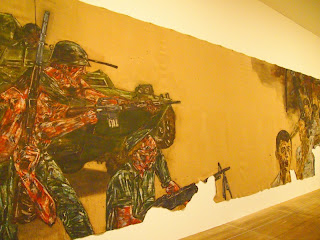Part of what makes Leon Golub's artwork is the process that he went through to create it. Golub took parts of different photographs and put them onto the canvas creating one flat image out of many. He then would go about outlining, shading, adding layers to create highlights, and adding color to show what was skin, metal, or cloth. After all that he put solvent on the painted areas dissolving the paint and then scraped it away. The process would take about two weeks. Finally he redefined the figures and cut out pieces of the fabric.
Somehow that process fits what is actually painted. In this painting their is violence, chaos, fear, and the idea of imminent death. Those ideas are as embedded in this painting, as the paint is embedded in the canvas. The paint blotches add panic and the boys face never loses the look of shear terror.
On the left are American soldiers and on the right are Vietnamese men, woman, and children. The soldiers have an armored vehicle and point two guns at the unarmed people. Golub clearly wants the viewers to side with the helpless people depicted on the right hand side of his painting.
Leon Golub painted three large artworks in 1973, fueled by the 1972 election of Nixon winning over anti-war supporter George McGovern. Golub had been against the Vietnam conflict for almost a decade by 1973 and had joined anti-war group artists. This was the first time he referenced these modern issues in his artwork.
Citation:
ABC. www.abc.es. Diario ABC, 05 April 2011. Web. 20 June 2013.
Racheal Taylor. www.tate.org.uk. Tate Modern, May 2004. Web. 20 June 2013.




























